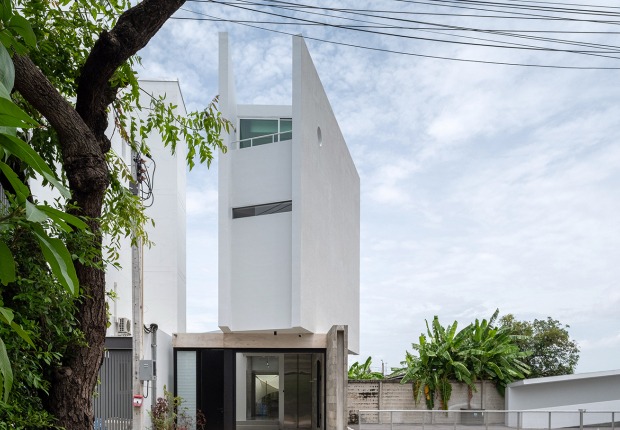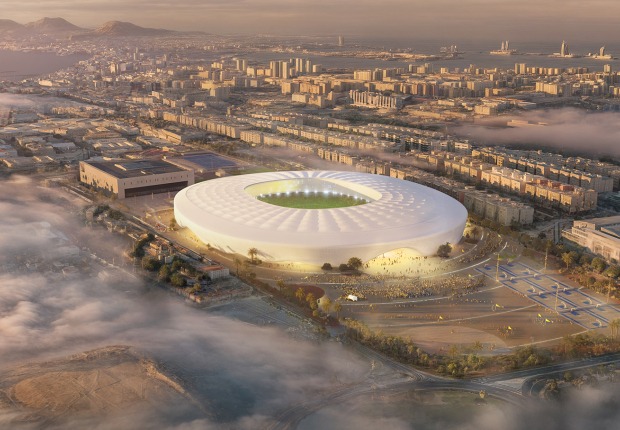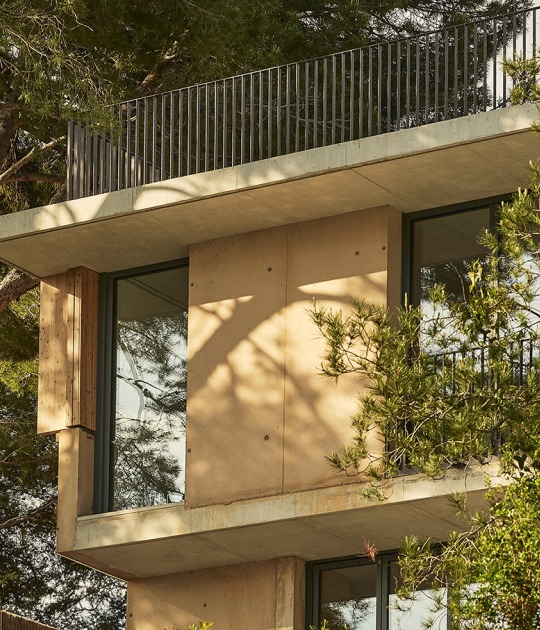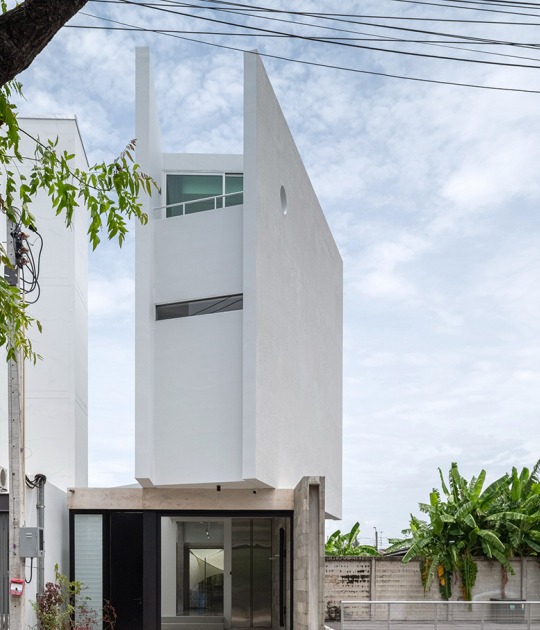
Two exposed reinforced concrete walls, leading into the calm of a sunken courtyard, guide the entrance to the house designed by Raúl Sánchez Architects. Descending, a space with little contact with the immediate exterior cuts across the immensity of the sky and prepares the visitor to enter the home.
Behind the doors, the proposal presents no hierarchies; there is no circulation space as such. The different living spaces are formed as the spaces on either side of the blocks that house the storage areas. The House in Cala Tamarit presents a proposal in which, through movement itself, one takes ownership of the different spaces, giving rise to a cozy and unique domestic experience.

House in Cala Tamarit by Raúl Sánchez. Photograph by David Zarzoso.
Project description by Raúl Sánchez Architects
“…a solid…heavy house.”
This phrase sums up how the future inhabitants— a couple who both work in the digital world and need only a laptop to do so—envisioned their home. And precisely because their work is so immaterial, they wanted their future house to be the opposite: material over immaterial, volume and mass over lightness, experience over immediacy. Accustomed to an environment where all that is solid melts into air, they longed for their home to provide not just shelter, but a tangible, physical experience.
The house takes shape between two exposed, tinted reinforced concrete walls, rendered in beige as required by local regulations. Toward the entrance, these walls fold inward to form a sunken entry courtyard, accessed by a staircase that runs between the two walls. Descending these stairs, one enters a world almost disconnected from the exterior—flanked by the heavy concrete walls (weathered and bearing the imprint of their formwork and construction process), with only the sky and interior of the house in view. Inside, the house resists clear spatial hierarchies: rooms take shape as the spaces left between solid blocks that contain storage, bathrooms, or the kitchen. These blocks are staggered rather than aligned, eliminating the traditional corridor. Movement through the house offers multiple paths to the same destination.

The interior experience is therefore fluid and varied, requiring exploration to be fully understood. From the entrance, the atmosphere is intimate and enclosed, yet the view toward the distant horizon is always present. Eventually, one reaches the kitchen, fully open to a landscape of pine trees. From both the kitchen and the entry, one can access the main living room—a double-height space that reveals itself upon crossing the threshold.
This room, in turn, extends toward the entrance courtyard through a more compressed zone, preparing the transition to that outdoor space. Both the double-height living room and the kitchen open onto a large terrace, offering expansive views of the landscape. From there, a descending path leads to the pool area, situated on the edge where the terrain drops into a ravine. On the upper floor are three bedrooms, each with its own bathroom. The basement level houses a playroom, an additional bedroom, and storage spaces.
A close reading of the house reveals a play of contrasts: the solidity of the concrete is subtly subverted by how it’s used—cantilevered balconies that seem to lack support, upper planes resting on voids, or a staircase slice that appears to split continuous slabs. This dual reading also applies to the lived experience of the house: enclosed yet open to the landscape; dark yet bright; rough yet smooth. The home resists simple definitions, embracing instead ambiguous qualities that enhance its phenomenological impact.

The selection of furniture follows the same logic, blending classics by Carlo Scarpa, Mackintosh, Le Corbusier, Mies van der Rohe or Miguel Milá (all sourced through FENIX Originals) with art-inflected pieces by contemporary designers like Maxime Halot and Alex Bellotti, represented by EastWest Space in Barcelona. Artworks by Francisco Suárez and Malgosia Jankowska—both from Víctor Lope Arte Contemporáneo gallery in Barcelona—have begun to occupy the walls, which were conceived to gradually host a growing family of art.
The house features radiant floor heating throughout and an efficient aerothermal system for both cooling and heating. Combined with natural cross-ventilation in all rooms, thoughtful orientation and shading strategies, a rainwater harvesting system, and a palette of local and simple materials, the home achieves a high level of environmental performance. Even the concrete was designed to reduce its carbon footprint: much of the Portland cement was replaced with natural pozzolans; recycled aggregates were used in place of quarried stone; and superplasticizers were added to minimize cement usage.

Additionally, the façade incorporates larch wood from sustainably managed forests. Wooden “ribs” on the façade provide shade to reduce overheating and help visually conceal windows on the side elevations that face neighbouring homes. The house’s layout also responds to the site’s topography: it is partially embedded into the terrain, balancing excavation and backfill. The basement is offset to align with the site's natural terraces.
Located in the idyllic setting of Cala Tamarit, just outside Tarragona, the plot has access from two roads, though entry is only from the upper street. Midway down, the terrain becomes a steep ravine with a slope exceeding 100%, making that lower portion not only inaccessible but practically unusable. The site is oriented northeast to southwest and lies just 150 meters from the sea. All proportions, both in plan and section, follow the golden ratio.



































































